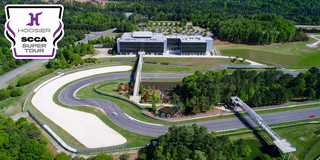
An electronic flagging assist will be coming to the Hoosier Racing Tire SCCA Super Tour and National Championship Runoffs in 2024. The Flagtronics electronic flagging system was utilized as an optional proof of concept during the 2023 Runoffs at VIRginia International Raceway with great success, leading to the decision to require the Flagtronics electronic flagging system at the 2024 Runoffs at Road America. Meanwhile, the use of the Flagtronics system will be encouraged, although not required, during the 2024 Hoosier Super Tour.
“Since 2022, our community has been discussing the importance of ‘Green-to-Checker,’ the idea that all sessions should have as few interruptions as possible. The use of the Flagtronics electronic flagging system will help us achieve that goal as well as provide a safer environment for participants,” said SCCA Vice President of Road Racing Eric Prill. “All racers know the importance of flags, but the reality is, a driver will occasionally miss flags at corner stations due to obstructed views or other distractions. The Flagtronics electronic flagging system places flags inside the race car cockpit via an LED display, making it easier for racers to stay aware of the course conditions.”
How Flagtronics Works
The Flagtronics electronic flagging system in no way replaces corner workers – it assists them. Flaggers will still display or wave the appropriate flags.
Each corner station at Hoosier Super Tour events and the Runoffs will have a Flagtronics wireless corner controller where a worker presses a button to change their local flag condition. The signal is immediately sent to race control, which then broadcasts the condition to vehicles within the GPS footprint or zone set for that station. Race control can also control an individual corner or a full-course condition.
The cars in that corner’s GPS zone receive the message and display the flag condition on the Flagtronics FT200 in-car display. SCCA rules still apply as to where the yellow zone starts and ends – this just adds the ability to view the flag inside the car, as well as at the corner station ahead.
Once the driver enters the next GPS zone that has a different flag condition, the in-car unit changes. It’s about line-of-sight to the station. The flag condition sent to the car is the same as what a driver will see via a physical flag at the station up ahead.
“Race control has a map of the track with each of the corner stations and their condition, each of the race cars with an in-car unit, and what their individual flag condition is – and even the safety trucks and pace car – to see where they are,” Prill said. “This is what they call a ‘marching ants’ display, where every vehicle displays on a Google Earth map.”

The Flagtronics system can also assist with the location of disabled vehicles. If a race car slows to a pre-determined speed, or stops, an alert is sent to race control and the car is highlighted on the screen. The GPS position can tell if the car is on or off course. If the car registers an impact over a pre-determined G load, race control receives a message, and the in-car unit asks if the driver is OK. The driver can acknowledge by pressing one of the buttons on the FT200 in-car unit. If the driver doesn’t respond, race control knows this and can respond appropriately.
The decision to require the use of Flagtronics at the 2024 Runoffs was driven by the system’s ability to allow race control to send safety and recovery teams onto the course without greatly impacting an entire session, thus increasing the amount of time the event will run under green-flag conditions. Additionally, providing better communication to drivers through the in-car unit will improve flag condition awareness and response, further reducing the potential of session interruptions and pass-under-yellow penalties. Required use at the Runoffs is the first step toward implementing it across the Road Racing program in future seasons.
“The safety benefits of having the additional notification for the drivers are clear, but the full capability can only be unlocked when all of the cars on track have the in-car unit,” Prill added. “Having the ability to slow the field, similar to what other organizations call ‘Code 35’ or ‘virtual safety car,’ can significantly improve everyone’s experience.”
How Much?
The current price of the in-car Flagtronics FT200 unit is $249.99, with a $10 upgrade if drivers opt for the wiring harness that has CAN bus capability. The standard FT200 unit is 3 inches wide by 1.25 inches tall, plus the antenna and wiring harness. Flagtronics is actively working on an even smaller unit that separates the unit into three components (display, control box, and external antenna), designed for the small cockpits of formula cars.
It’s important to note that there is no subscription for in-car flagging functionality.

“Drivers on a track have a certain responsibility of care for one another – it’s how you trust the driver you’re racing wheel-to-wheel with,” Prill added. “Similarly, SCCA has a responsibility to the care of the drivers, the safety teams, the flaggers, and all of the people putting on events. The Flagtronics FT200 unit is a relatively low-cost device that can ultimately provide a better racing experience, reduce the risk of damage, support better officiating and, most of all, reduce the risk of driver injuries.”
While Flagtronics is relatively new to SCCA, initial development began in 2016. Since its introduction in 2021, Flagtronics systems have been adopted by sanctioning bodies including SCCA Pro Racing, ChampCar, and SVRA. Read more about the Flagtronics FT200 unit by clicking here.
Photo by Jon Krolewicz and courtesy Flagtronics










